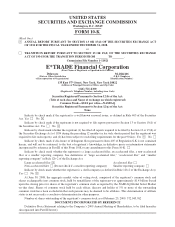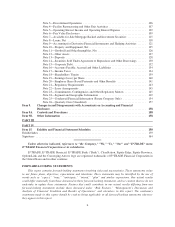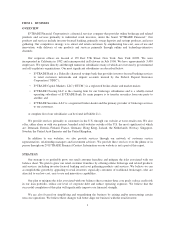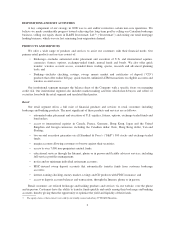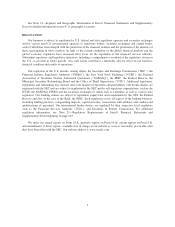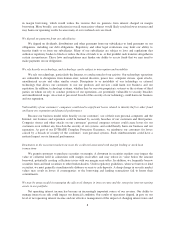eTrade 2008 Annual Report Download - page 10
Download and view the complete annual report
Please find page 10 of the 2008 eTrade annual report below. You can navigate through the pages in the report by either clicking on the pages listed below, or by using the keyword search tool below to find specific information within the annual report.billion of 12
1
⁄
2
% springing lien notes in 2007 and 2008. The annual interest cost of these securities alone is
approximately $257 million. Our total long-term debt is $3.2 billion and the expected annual interest cash outlay
is approximately $342 million, $257 million of which we have the option to pay in the form of additional 12
1
⁄
2
%
springing lien notes through May 2010. Our ratio of debt (our senior debt and term loans) to equity (expressed as
a percentage) was 106% at December 31, 2008. The degree to which we are leveraged could have important
consequences, including (i) a substantial portion of our cash flow from operations is dedicated to the payment of
principal and interest on our indebtedness, thereby reducing the funds available for other purposes; (ii) our ability
to obtain additional financing for working capital, capital expenditures, acquisitions and other corporate needs is
significantly limited; and (iii) our substantial leverage may place us at a competitive disadvantage, hinder our
ability to adjust rapidly to changing market conditions and make us more vulnerable in the event of a further
downturn in general economic conditions or our business. If regulatory requirements change in the future to
impose capital ratios at the holding company level, we could be required to significantly restructure our capital
position. In addition, a significant reduction in revenues could have a material adverse affect on our ability to
meet our obligations under our debt securities.
We are subject to investigations and lawsuits as a result of our losses from mortgage loans and asset-backed
securities
In 2007, we recognized an increased provision expense totaling $640 million and asset losses and
impairments of $2.45 billion, including the sale of our asset-backed securities portfolio to Citadel. As a result,
various plaintiffs filed class actions and derivative lawsuits, which have subsequently been consolidated into one
class action and one derivative lawsuit, alleging disclosure violations regarding our home equity, mortgage and
securities portfolios during 2007. In addition, the SEC initiated an informal inquiry into matters related to our
loan and securities portfolios. The defense of these matters has and will continue to entail considerable cost and
will be time-consuming for our management. Unfavorable outcomes in any of these matters could have a
material adverse effect on our business, financial condition, results of operations and cash flows.
Many of our competitors have greater financial, technical, marketing and other resources
The financial services industry is highly competitive, with multiple industry participants competing for the
same customers. Many of our competitors have longer operating histories and greater resources than we do and
offer a wider range of financial products and services. Other of our competitors offer a more narrow range of
financial products and services and have not been as susceptible to the disruptions in the credit markets that have
impacted our Company, and therefore have not suffered the losses we have. The impact of competitors with
superior name recognition, greater market acceptance, larger customer bases or stronger capital positions could
adversely affect our revenue growth and customer retention. Our competitors may also be able to respond more
quickly to new or changing opportunities and demands and withstand changing market conditions better than we
can. Competitors may conduct extensive promotional activities, offering better terms, lower prices and/or
different products and services or combination of products and services that could attract current E*TRADE
customers and potentially result in price wars within the industry. Some of our competitors may also benefit from
established relationships among themselves or with third parties enhancing their products and services.
The continuing turmoil in the global financial markets could reduce trade volumes and margin borrowing and
increase our dependence on our more active customers who receive lower pricing
Online investing services to the retail customer, including trading and margin lending, account for a
significant portion of our revenues. The continuing turmoil in the global financial markets could lead to changes
in volume and price levels of securities and futures transactions which may, in turn, result in lower trading
volumes and margin lending. In particular, a decrease in trading activity within our lower activity accounts or our
accounts related to stock plan administration products and services would significantly impact revenues and
increase dependence on more active trading customers who receive more favorable pricing based on their trade
volume. A decrease in trading activity or securities prices would also typically be expected to result in a decrease
7

